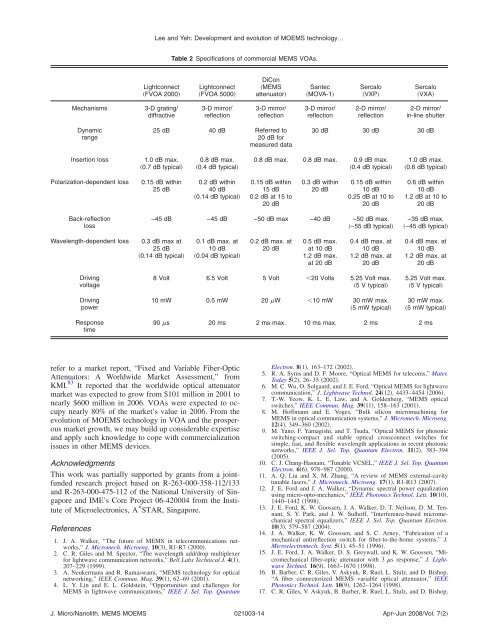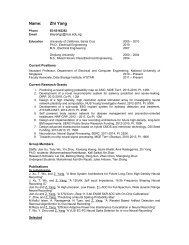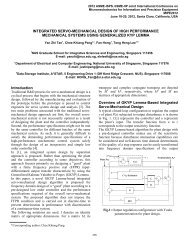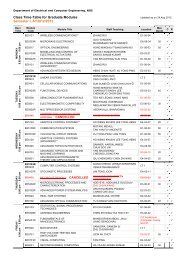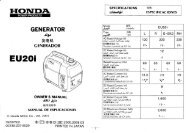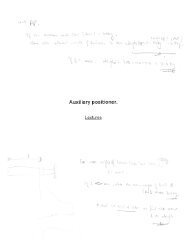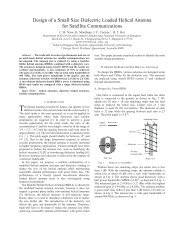Lee <strong>and</strong> Yeh: <strong>Development</strong> <strong>and</strong> <strong>evolution</strong> <strong>of</strong> <strong>MOEMS</strong> <strong>technology</strong>… Table 2 Specifications <strong>of</strong> commercial MEMS VOAs. Lightconnect FVOA 2000 Lightconnect FVOA 5000 DiCon MEMS attenuator Santec MOVA-1 Sercalo VXP Sercalo VXA Mechanisms 3-D grat<strong>in</strong>g/ diffractive 3-D mirror/ reflection 3-D mirror/ reflection 3-D mirror/ reflection 2-D mirror/ reflection 2-D mirror/ <strong>in</strong>-l<strong>in</strong>e shutter Dynamic range 25 dB 40 dB Referred to 20 dB for measured data 30 dB 30 dB 30 dB Insertion loss 1.0 dB max. 0.7 dB typical 0.8 dB max. 0.4 dB typical 0.8 dB max. 0.8 dB max. 0.9 dB max. 0.4 dB typical 1.0 dB max. 0.6 dB typical Polarization-dependent loss 0.15 dB with<strong>in</strong> 25 dB 0.2 dB with<strong>in</strong> 40 dB 0.14 dB typical 0.15 dB with<strong>in</strong> 15 dB 0.2dBat15to 20 dB 0.3 dB with<strong>in</strong> 20 dB 0.15 dB with<strong>in</strong> 10 dB 0.25 dB at 10 to 20 dB 0.6 dB with<strong>in</strong> 10 dB 1.2dBat10to 20 dB Back-reflection loss −45 dB −45 dB −50 dB max −40 dB −50 dB max. −55 dB typical −35 dB max. −45 dB typical Wavelength-dependent loss 0.3 dB max at 25 dB 0.14 dB typical 0.1 dB max. at 10 dB 0.04 dB typical 0.2 dB max. at 20 dB 0.5 dB max. at 10 dB 1.2 dB max. at 20 dB 0.4 dB max. at 10 dB 1.2 dB max. at 20 dB 0.4 dB max. at 10 dB 1.2 dB max. at 20 dB Driv<strong>in</strong>g voltage Driv<strong>in</strong>g power 8 Volt 6.5 Volt 5 Volt 20 Volts 5.25 Volt max. 5 V typical 10 mW 0.5 mW 20 W 10 mW 30 mW max. 5 mW typical 5.25 Volt max. 5 V typical 30 mW max. 5 mW typical Response time 90 s 20 ms 2 ms max. 10 ms max. 2 ms 2 ms refer to a market report, “Fixed <strong>and</strong> Variable Fiber-Optic Attenuators: A Worldwide Market Assessment,” from KMI. 83 It reported that the worldwide optical attenuator market was expected to grow from $101 million <strong>in</strong> 2001 to nearly $600 million <strong>in</strong> 2006. VOAs were expected to occupy nearly 80% <strong>of</strong> the market’s value <strong>in</strong> 2006. From the <strong>evolution</strong> <strong>of</strong> <strong>MOEMS</strong> <strong>technology</strong> <strong>in</strong> VOA <strong>and</strong> the prosperous market growth, we may build up considerable expertise <strong>and</strong> apply such knowledge to cope with commercialization issues <strong>in</strong> other MEMS devices. Acknowledgments This work was partially supported by grants from a jo<strong>in</strong>tfunded research project based on R-263-000-358-112/133 <strong>and</strong> R-263-000-475-112 <strong>of</strong> the National University <strong>of</strong> S<strong>in</strong>gapore <strong>and</strong> IME’s Core Project 06-420004 from the Institute <strong>of</strong> Microelectronics, A * STAR, S<strong>in</strong>gapore. References 1. J. A. Walker, “The future <strong>of</strong> MEMS <strong>in</strong> telecommunications networks,” J. Micromech. Microeng. 103, R1-R7 2000. 2. C. R. Giles <strong>and</strong> M. Spector, “The wavelength add/drop multiplexer for lightwave communication networks,” Bell Labs Technical J. 41, 207–229 1999. 3. A. Neukermans <strong>and</strong> R. Ramaswami, “MEMS <strong>technology</strong> for optical network<strong>in</strong>g,” IEEE Commun. Mag. 391, 62–69 2001. 4. L. Y. L<strong>in</strong> <strong>and</strong> E. L. Goldste<strong>in</strong>, “Opportunities <strong>and</strong> challenges for MEMS <strong>in</strong> lightwave communications,” IEEE J. Sel. Top. Quantum Electron. 81, 163–172 2002. 5. R. A. Syms <strong>and</strong> D. F. Moore, “Optical MEMS for telecoms,” Mater. Today 52, 26–35 2002. 6. M. C. Wu, O. Solgaard, <strong>and</strong> J. E. Ford, “Optical MEMS for lightwave communication,” J. Lightwave Technol. 2412, 4433–4454 2006. 7. T.-W. Yeow, K. L. E. Law, <strong>and</strong> A. Goldenberg, “MEMS optical switches,” IEEE Commun. Mag. 3911, 158–163 2001. 8. M. H<strong>of</strong>fmann <strong>and</strong> E. Voges, “Bulk silicon micromach<strong>in</strong><strong>in</strong>g for MEMS <strong>in</strong> optical communication systems,” J. Micromech. Microeng. 124, 349–360 2002. 9. M. Yano, F. Yamagishi, <strong>and</strong> T. Tsuda, “Optical MEMS for photonic switch<strong>in</strong>g-compact <strong>and</strong> stable optical crossconnect switches for simple, fast, <strong>and</strong> flexible wavelength applications <strong>in</strong> recent photonic networks,” IEEE J. Sel. Top. Quantum Electron. 112, 383–394 2005. 10. C. J. Chang-Hasna<strong>in</strong>, “Tunable VCSEL,” IEEE J. Sel. Top. Quantum Electron. 66, 978–987 2000. 11. A. Q. Liu <strong>and</strong> X. M. Zhang, “A review <strong>of</strong> MEMS external-cavity tunable lasers,” J. Micromech. Microeng. 171, R1-R13 2007. 12. J. E. Ford <strong>and</strong> J. A. Walker, “Dynamic spectral power equalization us<strong>in</strong>g micro-opto-mechanics,” IEEE Photonics Technol. Lett. 1010, 1440–1442 1998. 13. J. E. Ford, K. W. Goossen, J. A. Walker, D. T. Neilson, D. M. Tennant, S. Y. Park, <strong>and</strong> J. W. Sulh<strong>of</strong>f, “Interference-based micromechanical spectral equalizers,” IEEE J. Sel. Top. Quantum Electron. 103, 579–587 2004. 14. J. A. Walker, K. W. Goossen, <strong>and</strong> S. C. Arney, “Fabrication <strong>of</strong> a mechanical antireflection switch for fiber-to-the-home systems,” J. Microelectromech. Syst. 51, 45–51 1996. 15. J. E. Ford, J. A. Walker, D. S. Greywall, <strong>and</strong> K. W. Goossen, “Micromechanical fiber-optic attenuator with 3 s response,” J. Lightwave Technol. 169, 1663–1670 1998. 16. B. Barber, C. R. Giles, V. Askyuk, R. Ruel, L. Stulz, <strong>and</strong> D. Bishop, “A fiber connectorized MEMS <strong>variable</strong> optical attenuator,” IEEE Photonics Technol. Lett. 109, 1262–1264 1998. 17. C. R. Giles, V. Askyuk, B. Barber, R. Ruel, L. Stulz, <strong>and</strong> D. Bishop, J. Micro/Nanolith. MEMS <strong>MOEMS</strong> 021003-14 Apr–Jun 2008/Vol. 72
Lee <strong>and</strong> Yeh: <strong>Development</strong> <strong>and</strong> <strong>evolution</strong> <strong>of</strong> <strong>MOEMS</strong> <strong>technology</strong>… “A silicon MEMS optical switch attenuator <strong>and</strong> its use <strong>in</strong> lightwave subsystems,” IEEE J. Sel. Top. Quantum Electron. 51, 18–25 1999. 18. C. Marxer, P. Griss, <strong>and</strong> N. F. de Rooij, “A <strong>variable</strong> optical attenuator based on silicon micromechanics,” IEEE Photonics Technol. Lett. 112, 233–235 1999. 19. M. C. Wu, L. Y. L<strong>in</strong>, S. S. Lee, <strong>and</strong> C. R. K<strong>in</strong>g, “Free-space <strong>in</strong>tegrated optics realized by surface-micromach<strong>in</strong><strong>in</strong>g,” Int. J. High Speed Electron. Syst. 82, 283–297 1997. 20. R. S. Muller <strong>and</strong> K. Y. Lau, “Surface-micromach<strong>in</strong>ed microoptical elements <strong>and</strong> systems,” Proc. IEEE 868, 1705–1720 1998. 21. X. M. Zhang, A. Q. Liu, C. Lu, <strong>and</strong> D. Y. Tang, “MEMS <strong>variable</strong> optical attenuator us<strong>in</strong>g low driv<strong>in</strong>g voltage for DWDM systems,” Electron. Lett. 388, 382–383 2002. 22. A. Q. Liu, X. M. Zhang, C. Lu, F. Wang, C. Lu, <strong>and</strong> Z. S. Liu, “Optical <strong>and</strong> mechanical models for a <strong>variable</strong> optical attenuator us<strong>in</strong>g a micromirror drawbridge,” J. Micromech. Microeng. 133, 400– 411 2003. 23. X. M. Zhang, A. Q. Liu, C. Lu, F. Wang, <strong>and</strong> Z. S. Liu, “Polysilicon micromach<strong>in</strong>ed fiber-optical attenuator for DWDM applications,” Sens. Actuators, A 1081–3, 28–35 2003. 24. C. Lee, Y.-S. L<strong>in</strong>, Y.-J. Lai, M. H. Tsai, C. Chen, <strong>and</strong> C.-Y. Wu, “3-V driven pop-up micromirror for reflect<strong>in</strong>g light toward out-<strong>of</strong>-plane direction for VOA applications,” IEEE Photonics Technol. Lett. 164, 1044–1046 2004. 25. C. Lee <strong>and</strong> Y.-S. L<strong>in</strong>, “A new micromechanism for transformation <strong>of</strong> small displacements to large rotations for a VOA,” IEEE Sens. J. 44, 503–509 2004. 26. C. Lee, Y.-J. Lai, C.-Y. Wu, Y.-S. L<strong>in</strong>, M. H. Tsai, R.-S. Huang, <strong>and</strong> M.-S. L<strong>in</strong>, “Scratch drive actuator driven self-assembled <strong>variable</strong> optical attenuator,” Jpn. J. Appl. Phys., Part 1 436B, 3906–3909 2004. 27. C. Lee, Y.-J. Lai, C.-Y. Wu, J. A. Yeh, <strong>and</strong> R.-S. Huang, “Feasibility study <strong>of</strong> self-assembly mechanism for <strong>variable</strong> optical attenuator,” J. Micromech. Microeng. 151, 55–62 2005. 28. Lijie, J. Zawadzka, <strong>and</strong> D. Uttamch<strong>and</strong>ani, “Integrated selfassembl<strong>in</strong>g <strong>and</strong> hold<strong>in</strong>g technique applied to a 3-D MEMS <strong>variable</strong> optical attenuator,” J. Microelectromech. Syst. 131, 83–90 2004. 29. C.-H. Kim, N. Park, <strong>and</strong> Y.-K. Kim, “MEMS reflective type <strong>variable</strong> optical attenuator us<strong>in</strong>g <strong>of</strong>f-axis misalignment,” Proc. IEEE/LEOS Int. Conf. Opt. MEMS, pp. 55–56 2002. 30. C. Lee, “Challenges <strong>in</strong> optical MEMS commercialization <strong>and</strong> MEMS foundry,” presented at IEEE/LEOS Int. Conf. Opt. MEMS, Lugano, Switzerl<strong>and</strong>, 20–23 August 2002, IEEE 2002. 31. C. Chen, C. Lee, Y.-J. Lai, <strong>and</strong> W.-C. Chen, “<strong>Development</strong> <strong>and</strong> application <strong>of</strong> lateral comb drive actuator,” Jpn. J. Appl. Phys., Part 1 426B, 4059–4062 2003. 32. C. Chen, C. Lee, <strong>and</strong> Y.-J. Lai, “Novel VOA us<strong>in</strong>g <strong>in</strong>-plane reflective micromirror <strong>and</strong> <strong>of</strong>f-axis light attenuation,” IEEE Commun. Mag. 418, S16-S20 2003. 33. C.-H. Kim, J. Park, N. Park, <strong>and</strong> Y.-K. Kim, “MEMS fiber-optic <strong>variable</strong> optical attenuator us<strong>in</strong>g collimat<strong>in</strong>g lensed fiber,” Proc. IEEE/LEOS Int. Conf. Opt. MEMS, pp. 145–146 2003. 34. A. Bashir, P. Katila, N. Ogier, B. Saadany, <strong>and</strong> D. A. Khalil, “A MEMS-based VOA with very low PDL,” IEEE Photonics Technol. Lett. 164, 1047–1049 2004. 35. T.-S. Lim, C.-H. Ji, C.-H. Oh, Y. Yee, <strong>and</strong> J. U. Bu, “Electrostatic MEMS <strong>variable</strong> optical attenuator with folded micromirror,” Proc. IEEE/LEOS Int. Conf. Opt. MEMS, pp. 143–144 2003. 36. C. Lee, M. H. Tsai, C.-Y. Wu, S.-Y. Hung, C. Chen, Y.-J. Lai, M.-S. L<strong>in</strong>, <strong>and</strong> J. Andrew Yeh, “Characterization <strong>of</strong> <strong>MOEMS</strong> VOA based on various planar light attenuation configurations,” Proc. IEEE/LEOS Int. Conf. Opt. MEMS, pp. 98–99 2004. 37. C. Chen, C. Lee, <strong>and</strong> J. Andrew Yeh, “Retro-reflection type <strong>MOEMS</strong> VOA,” IEEE Photonics Technol. Lett. 1610, 2290–2292 2004. 38. T.-S. Lim, C.-H. Ji, C.-H. Oh, H. Kwon, Y. Yee, <strong>and</strong> J. U. Bu, “Electrostatic MEMS <strong>variable</strong> optical attenuator with rotat<strong>in</strong>g folded micromirror,” IEEE J. Sel. Top. Quantum Electron. 103, 558–562 2004. 39. J. A. Yeh, S.-S. Jiang, <strong>and</strong> C. Lee, “<strong>MOEMS</strong> VOA us<strong>in</strong>g rotary comb drive actuators,” IEEE Photonics Technol. Lett. 1810, 1170–1172 2006. 40. C.-H. Kim <strong>and</strong> Y.-K. Kim, “MEMS <strong>variable</strong> optical attenuator us<strong>in</strong>g translation motion <strong>of</strong> 45-deg tilted vertical mirror,” J. Micromech. Microeng. 158, 1466–1475 2005. 41. J. H. Lee, Y. Y. Kim, S. S. Yun, H. Kwon, Y. S. Hong, J. H. Lee, <strong>and</strong> S. C. Jung, “Design <strong>and</strong> characteristics <strong>of</strong> a micromach<strong>in</strong>ed <strong>variable</strong> optical attenuator with a silicon optical wedge,” Opt. Commun. 2214–6, 323–330 2003. 42. Y. Y. Kim, S. S. Yun, C. S. Park, J.-H. Lee, Y. G. Lee, H. K. Lee, S. K. Yoon, <strong>and</strong> J. S. Kang, “Refractive <strong>variable</strong> optical attenuator fabricated by silicon deep reactive ion etch<strong>in</strong>g,” IEEE Photonics Technol. Lett. 162, 485–487 2004. 43. J. H. Lee, S. S. Yun, Y. Y. Kim, <strong>and</strong> K.-W. Jo, “Optical characteristics <strong>of</strong> a refractive optical attenuator with respect to the wedge angles <strong>of</strong> a silicon optical leaker,” Appl. Opt. 434, 877–882 2004. 44. H. Cai, X. M. Zhang, C. Lu, A. Q. Liu, <strong>and</strong> E. H. Khoo, “L<strong>in</strong>ear MEMS <strong>variable</strong> optical attenuator us<strong>in</strong>g reflective elliptical mirror,” IEEE Photonics Technol. Lett. 172, 402–404 2005. 45. X. M. Zhang, A. Q. Liu, H. Cai, A. B. Yu, <strong>and</strong> C. Lu, “Retro-axial VOA us<strong>in</strong>g parabolic mirror pair,” IEEE Photonics Technol. Lett. 199, 692–694 2007. 46. M. G. Kim <strong>and</strong> J.-H. Lee, “A discrete position<strong>in</strong>g microactuator: l<strong>in</strong>earity model<strong>in</strong>g <strong>and</strong> VOA application,” J. Microelectromech. Syst. 161, 16–23 2007. 47. Q. W. Zhao, X. M. Zhang, A. Q. Liu, H. Cai, J. Zhang, <strong>and</strong> C. Lu, “Theoretical <strong>and</strong> experimental studies <strong>of</strong> MEMS dual-shutter VOA for l<strong>in</strong>ear attenuation relationship <strong>and</strong> ultra-f<strong>in</strong>e tun<strong>in</strong>g,” J. Lightwave Technol.. 265, 569–579 2008. 48. J. C. Chiou <strong>and</strong> W. T. L<strong>in</strong>, “Variable optical attenuator us<strong>in</strong>g a thermal actuator array with dual shutters,” Opt. Commun. 2374–6, 341– 350 2004. 49. B. Glushko, S. Krylov, M. Med<strong>in</strong>a, <strong>and</strong> D. K<strong>in</strong>, “Insertion type MEMS VOA with two transparent shutters,” Proc. Asia-Pacific Conf. Transducers Micro-Nano Technol. (APCOT), Paper No. 95-OMN- A0594 2006. 50. C. Lee, “<strong>MOEMS</strong> <strong>variable</strong> optical attenuator with robust design for improved dynamic characteristics,” IEEE Photonics Technol. Lett. 186, 773–775 2006. 51. C. Lee, “Variable optical attenuator us<strong>in</strong>g planar light attenuation scheme based on rotational <strong>and</strong> translational misalignment,” Microsyst. Technol. 131, 41–48 2007. 52. B. M. Andersen, S. Fairchild, N. Thorsten, <strong>and</strong> V. Aksyuk, “MEMS <strong>variable</strong> optical amplifiers,” Proc. Opt. Fiber Commun. Conf. 2, 260– 262 2000. 53. N. A. Riza <strong>and</strong> S. Sumriddetchkajorn, “Digitally controlled faulttolerant multiwavelength programmable fiber-optic attenuator us<strong>in</strong>g a two-dimensional digital micromirror device,” Opt. Lett. 245, 282– 284 1999. 54. K. C. Rob<strong>in</strong>son, “Variable optical attenuator,” U.S. Patent No. 6137941 2000. 55. H. Schenk, A. Wolter, U. Dauderstaedt, A. Gehner, <strong>and</strong> H. Lakner, “Microoptoelectromechanical systems <strong>technology</strong> <strong>and</strong> its impact on photonic applications,” J. Microlithogr., Micr<strong>of</strong>abr., Microsyst. 44, 041501 2005. 56. K. Isamoto, K. Kato, A. Morosawa, C. Chong, H. Fujita, <strong>and</strong> H. Toshiyoshi, “Micromechanical VOA design for high shock-tolerance <strong>and</strong> low temperature-dependence,” Proc. IEEE/LEOS Int. Conf. Opt. MEMS, pp. 113–114 2003. 57. K. Isamoto, K. Kato, A. Morosawa, C. Chong, H. Fujita, <strong>and</strong> H. Toshiyoshi, “A 5-Voperated MEMS <strong>variable</strong> optical attenuator by SOI bulk micromach<strong>in</strong><strong>in</strong>g,” IEEE J. Sel. Top. Quantum Electron. 103, 570–578 2004. 58. K. Isamoto, A. Morosawa, M. Tei, H. Fujita, <strong>and</strong> H. Toshiyoshi, “MEMS <strong>variable</strong> optical attenuator us<strong>in</strong>g asymmetrically driven parallel plate tilt mirror,” IEEJ Trans. Sars. Micromech. 1246, 213– 218 2004. 59. O. Solgaard, F. S. A. S<strong>and</strong>ejas, <strong>and</strong> D. M. Bloom, “Deformable grat<strong>in</strong>g optical modulator,” Opt. Lett. 179, 688–690 1992. 60. A. Godil, “Diffractive MEMS <strong>technology</strong> <strong>of</strong>fers a new platform for optical networks,” Laser Focus World 385, 181–185 2002. 61. http://www.lightconnect.com/. 62. N. A. Riza <strong>and</strong> F. N. Ghauri, “Hybrid analog-digital MEMS fiberoptic <strong>variable</strong> attenuator,” IEEE Photonics Technol. Lett. 171, 124– 126 2005. 63. W. Sun, W. Noell, M. Zickar, M. J. Mughal, F. Perez, N. A. Riza, <strong>and</strong> N. F. de Rooij, “Design, simulation, fabrication, <strong>and</strong> characterization <strong>of</strong> a digital <strong>variable</strong> optical attenuator,” J. Microelectromech. Syst. 155, 1190–1200 2006. 64. C. Lee, “Monolithic-<strong>in</strong>tegrated 8CH MEMS <strong>variable</strong> optical attenuators,” Sens. Actuators, A 123–124, 596–601 2005. 65. C. Lee, “Arrayed <strong>variable</strong> optical attenuator us<strong>in</strong>g retro-reflective MEMS mirrors,” IEEE Photonics Technol. Lett. 1712, 2640–2642 2005. 66. C. Lee, “A MEMS VOA us<strong>in</strong>g electrothermal actuators,” J. Lightwave Technol. 252, 490–498 2007. 67. I. Ogawa, Y. Doi, Y. Hashizume, S. Kamei, Y. Tamura, M. Ishii, T. Kom<strong>in</strong>ato, H. Yamazaki, <strong>and</strong> A. Kaneko, “Packag<strong>in</strong>g <strong>technology</strong> for ultra-small <strong>variable</strong> optical attenuator multiplexer V-AWG with multichip plc <strong>in</strong>tegration structure us<strong>in</strong>g chip-scale-package PD array,” IEEE J. Sel. Top. Quantum Electron. 125, 1045–1053 2006. 68. P. De Dobbelaere, K. Falta, <strong>and</strong> S. Gloeckner, “Advances <strong>in</strong> <strong>in</strong>tegrated 2D MEMS-based solutions for optical network applications,” IEEE Commun. Mag. 415, S16–S23 2003. 69. R. R. A. Syms, H. Zou, J. Stagg, <strong>and</strong> D. F. Moore, “Multistate latch<strong>in</strong>g MEMS <strong>variable</strong> optical attenuator,” IEEE Photonics Technol. Lett. 161, 191–193 2004. 70. R. R. A. Syms, H. Zou, <strong>and</strong> P. Boyle, “Mechanical stability <strong>of</strong> a latch<strong>in</strong>g MEMS <strong>variable</strong> optical attenuator,” J. Microelectromech. Syst. 143, 529–538 2005. J. Micro/Nanolith. MEMS <strong>MOEMS</strong> 021003-15 Apr–Jun 2008/Vol. 72


